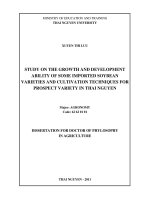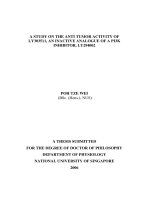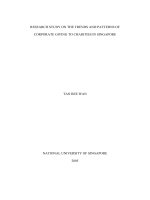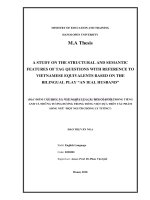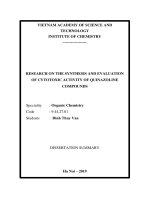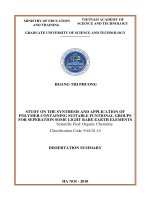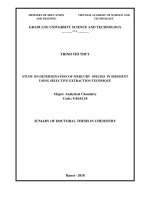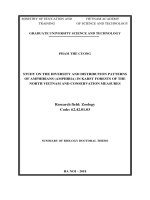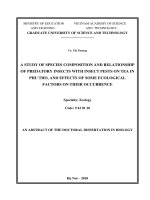Dissertation summary Organic chemistry: Study on the manufacturing and properties of gas barrier multilayers films and applications - Trường Đại học Công nghiệp Thực phẩm Tp. Hồ Chí Minh
Bạn đang xem bản rút gọn của tài liệu. Xem và tải ngay bản đầy đủ của tài liệu tại đây (725.83 KB, 10 trang )
<span class='text_page_counter'>(1)</span><div class='page_container' data-page=1>
<b>MINISTERY OF EDUCATION </b>
<b>AND TRAINING</b>
<b>VIETNAM ACADEMY OF </b>
<b>SCIENCE AND TECHNOLOGY </b>
<b>GRADUATE UNIVERSITY OF SCIENCE AND TECHNOLOGY </b>
<b>--- </b>
<b>NGUYEN TUAN NAM </b>
<b>STUDY ON THE MANUFACTURING AND PROPERTIES OF GAS </b>
<b>BARRIER MULTILAYERS FILMS AND APPLICATIONS </b>
<b>Scientific Field: Organic Chemistry</b>
<b>Classification Code: 62 44 01 14</b>
<b>DISSERTATION SUMMARY</b>
</div>
<span class='text_page_counter'>(2)</span><div class='page_container' data-page=2>
The dissertation was completed at:
Institute of Chemistry
Vietnam Academy of Science and Technology
Scientific Supervisors:
1. Dr. Nguyen Tien Dung
The Faculty of Chemistry – Hanoi National University of Education
2. Dr. Nguyen Thanh Tung
Institute of Chemistry - Vietnam Academy of Science and Technology
1st Reviewer: ...
...
...
2nd Reviewer: ...
...
...
3rd Reviewer: ...
...
...
The dissertation will be defended at Graduate University of Science And
Technology, Vietnam Academy of Science and Technology, 18 Hoang Quoc
Viet, Cau Giay District, Ha Noi City.
At ….. hour….. date….. month …..2020.
</div>
<span class='text_page_counter'>(3)</span><div class='page_container' data-page=3>
1
<b>A. INTRODUCTION </b>
<b>1. Background</b>
Packaging plays an important role in the food supply chain. They are
not only used to store, preserve and transport products but also used as a
marketing tool to bring added value to the product. Packaging protects food
from environmental influences such as oxygen, moisture, light, dust, volatile
compounds and microorganisms [1], it acts as a barrier between the
atmosphere around food and the outside environment. Oxygen and steam are
the two main reasons leading to the deterioration of food quality. Therefore,
the development of the gas barrier packaging products with low air and water
vapor permeability is a research direction that has been interested recently.
According to Smithers Pira, in 2015, the world consumed about 1.4 million
tons of gas barrier packaging films, in 2016 it was 1.86 million tons, with the
growth rate of 4.7%/year. The regions using the most gas barrier packaging
films were Asia-Pacific with 30.9%, followed by Western Europe (27.6%)
and North America (26.8%).
Among the materials used for packaging, plastic in the form of thin
films has many outstanding advantages compared to other packaging types
such as: light, durable, elastic, transparent, resistant to air and vapor. High
water, and at the same time have good heat sealing and sealing ability.
Polyethylene (PE) is the most commonly used plastic for packaging thanks to
its good moisture barrier, low cost, but poor resistance to O2, aromas and
essential oils. Like PE, PA6 has good moisture barrier but poor O2 and CO2
barrier. Therefore, the recent trend that scientists are most interested in
developing is to combine these polymers with another polymer with high gas
barrier ability in the form of polymer blends or multilayer films. The most
widely used and highly gas barrier polymer is EVOH [2]. Combining EVOH
with PE or PA6 can create a material that has both highly mechanical and
good gas, solvent, and moisture resistance, suitable for applications requiring
high gas barrier such as food packaging or dry agricultural packaging ...
Agriculture plays an important role in Vietnam's economy with great
developments. However, post-harvest losses of agricultural products are still
high, from 15-20% for foods, the main reason is that the research, application
and deployment of post-harvest technologies have not timely responded and
are full of requirements. In the country, there are also studies on the use of
gas barrier packaging to preserve dry food and agricultural products, but the
gas barrier packaging products on the market today are all imported products
with expensive prices. Stemming from the above problems, the thesis focuses
on: "<b>Study on the manufacturing and properties of gas barrier </b>
</div>
<span class='text_page_counter'>(4)</span><div class='page_container' data-page=4>
<b>2. Objectives of the dissertation </b>
Researching and fabricating gas barrier multilayer films based on the
polyme blends and exploring the applicability of packaging to preserve dry
agricultural products.
<b>3. Main contents of the thesis </b>
- Study on fabrication and properties of some polymer blends based on
EVOH (PE/EVOH and PA6/EVOH polymer blends).
- Fabrication and study on properties of gas barrier multilayer polymeric
films based on polymer blends of EVOH.
- Study on application of gas barrier multilayer packaging to preserve
some dry agricultural products (maize, soybeans).
<b>4. Cấu trúc của luận án </b>
The dissertation has 111 pages, including the Preface, Chapter 1:
Overview, Chapter 2: Experiment, Chapter 3: Results and discussions,
Chapter 4: Conclusions, Pubblications, with 29 images, 21 tables and 90
references.
<b>DISSERTATION CONTENTS </b>
<b>CHAPTER 1. LITERATURE REVIEW </b>
In Vietnam, although the share of the agricultural sector in the country's
GDP has decreased in recent years, its contribution to growth has remained
stable at 16-18%. The agricultural still plays an important role when it creates
more than 40% of total employment for the whole country. According to the
World Food and Agriculture Organization (FAO), postharvest losses in
developing countries amount to 20-30%. In our country, the statistics show
that the loss of yield during and after harvest for rice of 11-13%, maize of
13-15%, concentrated in the stages of harvesting, drying, preserving and milling.
The main cause is due to harvesting, packaging, transport and storage. On the
basis of synthesizing domestic and foreign research documents, it can be seen
that gas barrier storage is an advanced preservation method, widely applied in
the world today. Packaging materials capable barrier of gas, moisture and
solvents are increasingly popular, especially in the field of food preservation
and dry food. However, non-polar hydrocarbon solvents and their mixtures
(such as xylene, toluene, white oil, etc.) can easily seep through the
conventional polymer packaging (PE and PP) to degrade and cause health
and food safety issues. Therefore, combining polymers with specific features
into new polymer materials that have all the preeminent features of the
component polymers, meeting the technical requirements of gas barrier
</div>
<span class='text_page_counter'>(5)</span><div class='page_container' data-page=5>
3
Studies have shown that EVOH has good hydrocarbon barrier
properties and is considered an oxygen barrier in food packaging applications
where oxygen is essential due to its high oil resistance and gas barrier
properties. However, its moisture-absorbing properties, being relatively
brittle and expensive, diminish its advantages. In order to reduce costs while
maintaining good gas barrier properties, studies on polymer blends of EVOH
have attracted a lot of attention in recent years, especially polymer blends of
EVOH with PE and PA6.
In the gas barrier packaging technology, the multi-layer extrusion
technology proved to be effective in improving the poor gas barrier
properties of polyolefin packaging. This technique allows the desired
properties of polymers to be combined into one structure with enhanced
performance. In this way it is possible to take advantage of the inherent
barrier properties and protect the plastic layer from high relatively humidity.
In addition, this plastic layer is also protected from corrosion, avoiding
miscibility problems and improving transparency of film.
In Vietnam, there are no research projects on manufacturing gas-barrier
multilayer polymeric packaging for agricultural preservation applications,
especially dry agricultural products. Therefore, this dissertation chooses the
topic "Study on the manufacturing and properties of gas barrier multilayer
films and applications".
<b>CHAPTER 2. EXPERIMENTS </b>
<b>2.1. Materials and equipments </b>
<i><b>2.1.1. Materials </b></i>
Linear low density polyethylene (LLDPE), ethylene-vinyl alcohol
copolymer (EVOH), low density polyethylene graft maleic anhydride
(PE-g-MAH, MAH content of 0,1%), polyamide 6 (PA6), corn seed HQ 2000,
soybean seed DT96.
<i><b>2.1.2. Equipments </b></i>
</div>
<span class='text_page_counter'>(6)</span><div class='page_container' data-page=6>
<b>2.2. Study methods </b>
<i><b>2.2.1. Preparation of polymer blends based on EVOH </b></i>
<i>2.2.1.1. Preparation of PE/EVOH polymer blends </i>
LLDPE and EVOH resins, PE-g-MAH compatibilizer were melt-blended
in an internal mixer model Plastograph® EC (Germany) at 190 oC, rotor speed
of 45 rpm for 5 min. The PE/EVOH polymer blends were compression
moulded into 1 mm thick plates on a GoTech hot press at 190 oC at a pressure
of 20MPa for 5 min.
<i>2.2.1.2. Preparation of PA6/EVOH polymer blends </i>
PA6 and EVOH resins were melt-blended in an internal mixer model
Plastograph® EC (Germany) at 215 oC, rotor speed of 30 rpm for 5 min. The
PA6/EVOH polymer blends were compression moulded into 1 mm thick
plates on a GoTech hot press at 190 oC at a pressure of 20MPa for 5 min.
<i><b>2.2.2. Preparation of gas barrier multilayer films based on EVOH </b></i>
<i>2.2.2.1. Preparation of PE/PE-EVOH/PE gas barrier multilayer films </i>
The film blowing process was performed on a multi-layer film blowing
device Model 3SJ-G2000, with the following layer structure:
LLDPE/PE-g-MAH polymer blend (layer 1)/PE/EVOH polymer blend (layer 2)/LLDPE/
PE-g-MAH polymer blend (grade 3). The parameters of the 3 screws in the
film blowing device are as follows: screws 1 and 3 with a diameter of 65mm,
the ratio of L/D = 30, the temperature of the heating zones and die heads are
180, 190, 200, 210, 210oC, screw speed 20 rpm; screw 2 has a diameter of
70mm, the ratio L/D = 30, the temperature of the heating zones and the die
head is 210, 210, 220, 220, 220oC, screw speed 15 rpm.
<i>2.2.2.2. Preparation of PE/PA-EVOH/PE gas barrier multilayer films </i>
The film blowing process was performed on a multi-layer film blowing
device Model 3SJ-G2000, with the following layer structure:
LLDPE/PE-g-MAH polymer blend (layer 1)/ PA6/EVOH polymer blend (layer 2)/LLDPE/
PE-g-MAH polymer blend (grade 3). The parameters of the 3 screws in the
film blowing device are as follows: screws 1 and 3 with a diameter of 65mm,
the ratio of L/D = 30, the temperature of the heating zones and die heads are
180, 190, 200, 210, 210oC, screw speed 20 rpm; screw 2 has a diameter of
70mm, the ratio L/D = 30, the temperature of the heating zones and the die
head is 230, 230, 240, 240, 240oC, screw speed 15 rpm.
<i><b>2.2.3. Application of gas barrier multilayer films in the preservation of </b></i>
<i><b>some dry agricultural products </b></i>
<i>2.3.3.1. Application of gas barrier multilayer films in the preservation of </i>
<i>maize grain </i>
</div>
<span class='text_page_counter'>(7)</span><div class='page_container' data-page=7>
5
indicators such as: moisture, protein, starch, lipid content and yeast-mold
infection degree every month.
<i>2.3.3.2. Application of gas barrier multilayer films in the preservation of </i>
<i>soybean </i>
Soybean was selected according to standard TCVN 4849:1989, is
packed into bags with the size of 25x35cm, and thickness of 80 µm, weight 2
kg/bag, then vacuumed on the BZQ 500 machine (vacuum pressure
-0.08MPa). The packed samples are stored in the laboratory. Samples were
analyzed quality indicators such as: moisture, protein, lipid content, acidity in
extract oil and yeast-mold infection degree every month.
<b>CHAPTER 3. RESULTS AND DISCUSSIONS </b>
<b>3.1. Study on preparation of polymer blends based on EVOH </b>
The dissertation has investigated two factors affecting the properties of
the material: compatibilizer content and the ratio of LLDPE/EVOH.
- The effect of the ratio of LLDPE / EVOH: content of LLDPE-g-MAH
compatibilizer 4%, weight ratio of PE/EVOH in polymer blends 90/10,
80/20, 70/30, 60/40, 50/50.
- The effect of the LLDPE-g-MAH compatibilizer content: the ratio of
LLDPE/EVOH 70/30, compatibilizer content of 0-10%.
<i><b>3.1.1. Study on preparation of PE/EVOH polymer blends </b></i>
<i>3.1.1.1. Viscosity of PE/EVOH polymer blends </i>
* Effect of the ratio PE/EVOH on the viscosity PE/EVOH polymer
blends
Curves of mixing torque versus time for PE/EVOH polymer blends
containing 4% LLDPE-g-MAH compatibilizer at different PE/EVOH ratios
were shown in fig. 3.1.
<i>Fig. 3.1.</i> Curves of mixing torque versus time for PE/EVOH polymer blends
</div>
<span class='text_page_counter'>(8)</span><div class='page_container' data-page=8>
Specifically, torque of PE/EVOH polymer blend in molten equilibrium with
the ratios of 90/10, 80/20, 70/30, 60/40 and 50/50 are 15.7; 17.8; 18.7; 19.4
and 19.9 N.m, respectively.
* The effect of the PE-g-MAH content on the viscosity of the
PE/EVOH polymer blend was shown in fig. 3.2.
<i>Fig. 3.2.</i> Curves of mixing torque versus time for PE/EVOH 70/30 polymer
blend with different PE-g-MAH content
Fig. 3.2 showed that when the PE-g-MAH compatibilizer was present,
torque in the molten state of PE/EVOH polymer blends increased as
compared to when not using the compatibilizer even though PE-g-MAH has
low viscosity. The results also showed that when increasing the content of
PE-g-MAH compatibilizer, the torque of the polymer blend increased.
<i>3.1.1.3. Mechanical properties of PE/EVOH polyme blends </i>
Effects of PE/EVOH ratio on mechanical properties of PE/EVOH
polymer blends with and without PE-g-MAH compatibilizer were presented
in Table 3.1.
Table 3.1. Effect of the composition ratio on the mechanical properties
of PE/EVOH polymer blend
<b>PE/EVOH </b>
<b>ratio </b>
<b>PE-g-MAH </b>
<b>compatibilizer (%) </b>
<b>Tensile </b>
<b>strength (MPa) </b>
<b>Elongation at </b>
<b>break (%) </b>
100/0
0
29.5 1005.4
90/10 19.6 765.7
80/20 15.8 420.3
70/30 12.4 256.2
60/40 10.1 148.5
50/50 7.6 89.6
0/100 25.2 17.1
90/10
4
24.5 359.2
80/20 26.4 389.3
70/30 28.3 404.9
60/40 27.1 367.5
</div>
<span class='text_page_counter'>(9)</span><div class='page_container' data-page=9>
7
In samples without PE-g-MAH compatibilizer, both tensile strength
and elongation at break of the polyme blend samples decreased with
increasing EVOH content. This is because PE and EVOH have differences in
nature, chemical structure, polarity, surface interaction energy ... so the low
adhesion between PE and EVOH leads to agglomeration of a large EVOH
amount in the PE matrix.
In the presence of a compatibilizer, the mechanical properties of the
polymer blends were significantly improved. Tensile strength and elongation
at break increased because PE-g-MAH acted as an effective compatibilizer
between EVOH dispersion phase and PE matrix. Adding PE-g-MAH
increased the dispersion of EVOH and increases the adhesion between phases
to enhance the mechanical properties of polymer blends.
The results also showed that in the presence of 4% compatibilizer,
when the EVOH content increased from 10-30%, the tensile strength and
elongation at break increased. Tensile strength was significantly improved
when increasing EVOH content in polymer blends possibly due to high
tensile strength of EVOH. However, when the EVOH content was > 30%, the
mechanical properties of the polymer blends decrease because the tensile
strength was strongly influenced by the phase interaction between PE and
EVOH. This showed that when the EVOH content increased, the binding
capacity of PE and EVOH decreased.
The effect of the PE-g-MAH content on the mechanical properties of
the PE/EVOH polymer blends was presented in Table 3.2.
Table 3.2. Effect of PE-g-MAH content on mechanical properties of
PE/EVOH 70/30 polymer blend
PE-g-MAH content
(%)
Tensile strength
(MPa)
Elongation at break
(%)
0 12.4 256.2
2 25.6 379.8
4 28.3 404.9
6 26.5 416.3
8 24.1 420.4
10 23.9 418.5
</div>
<span class='text_page_counter'>(10)</span><div class='page_container' data-page=10>
<i>3.1.1.4. Surface morphology of PE/EVOH polymer blends </i>
SEM images of fracture surface of PE/EVOH polymer blends without
and with PE-g-MAH compatibilizer wre shown in Figure 3.6 and Figure 3.7.
a) PE/EVOH 90/10 b) PE/EVOH 80/20 c) PE/EVOH 70/30
d) PE/EVOH 60/40 <sub>e) PE/EVOH 50/50 </sub>
<i>Fig. 3.4. SEM images of fracture surface of PE/EVOH polymer blends </i>
without PE-g-MAH compatibilizer
a) PE/EVOH 90/10 b) PE/EVOH 80/20 c) PE/EVOH 70/30
d) PE/EVOH 60/40 e) PE/EVOH 50/50
<i>Fig. 3.5. SEM images of fracture surface of PE/EVOH polymer blends with </i>
4% PE-g-MAH compatibilizer
</div>
<!--links-->
